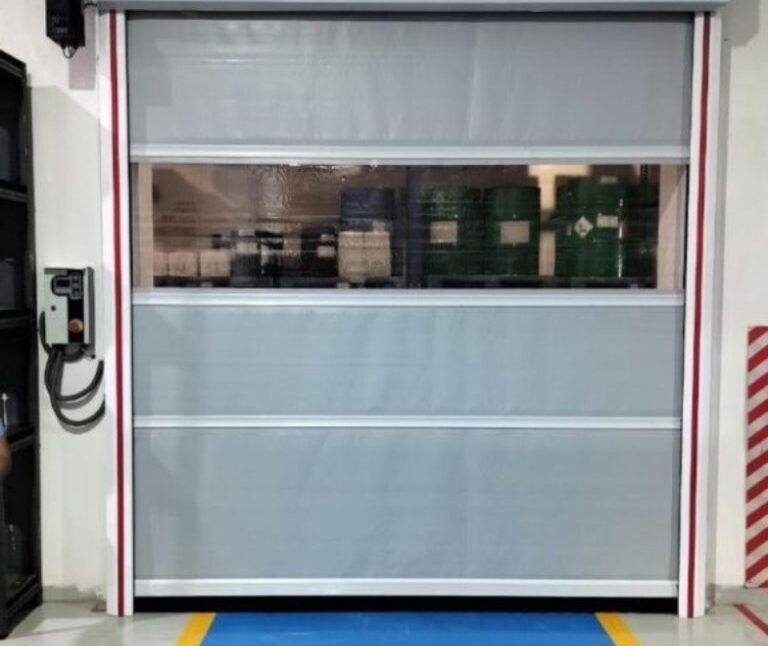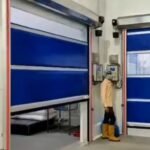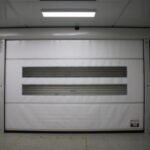Internal Roll-Up Doors
Internal Roll-Up Doors When you think of roll-up doors, garage entrances or loading docks likely come to mind. But there’s another version quietly serving essential roles inside buildings: the internal roll-up door. These compact, efficient, and high-performing doors are designed specifically for indoor spaces where space, cleanliness, and speed matter most.
Let’s break down what makes these doors a smart choice for many businesses.
What is an Internal Roll-Up Door?
An internal roll-up door is a flexible barrier made from durable materials like vinyl, PVC, or lightweight aluminum. Unlike traditional doors that swing or slide open, this type of door rolls vertically into a compact coil above the doorway. It saves space and operates quickly—ideal for high-traffic or space-restricted areas.
Where Are Internal Roll-Up Doors Used?
You’ll find these doors in a variety of settings, including:
- Warehouses – Dividing packing and storage zones.
- Food Processing Plants – Maintaining hygiene and separating processing areas.
- Manufacturing Facilities – Isolating machinery or clean areas.
- Retail Stores – Hiding storage or inventory spaces.
- Hospitals – Keeping sterile environments intact.
- Commercial Kitchens – Separating prep and service areas.
They’re used anywhere cleanliness, climate control, or space optimization is critical.
Why Choose an Internal Roll-Up Door?
These doors offer a unique set of advantages:
1. Space Saving
Their vertical roll-up design means no extra room is needed to swing or slide the door. This is perfect for small or busy areas.
2. Speed and Efficiency
Designed for fast opening and closing, internal roll-up doors help maintain workflow and reduce delays in active environments.
3. Climate and Contamination Control
They seal tightly, which helps maintain temperature zones and prevent the spread of dust, fumes, and contaminants.
4. Hygiene and Cleanliness
The non-porous surface of many roll-up door materials is easy to clean—essential for food and healthcare environments.
5. Safety Features
Modern doors come with safety sensors, emergency stops, and soft bottom edges to avoid accidents and injuries.
6. Durability and Low Maintenance
Built to withstand frequent use, these doors require minimal maintenance and offer a long service life.
7. Custom Options
Available in a range of materials, colors, insulation levels, and sizes to suit any environment or operational need.
How Do Internal Roll-Up Doors Work?
Despite their modern look, the working mechanism is simple:
- Curtain/Panel – The flexible sheet that acts as the door.
- Drum/Barrel – The cylinder above the doorway where the curtain rolls up.
- Side Tracks – Guides that ensure smooth movement.
- Motor System – Powers the rolling motion for automatic doors.
- Controls – Operated via buttons, sensors, pull cords, or integration with smart systems.
With a press or trigger, the motor rolls the curtain up into the barrel. When closing, it unrolls neatly to cover the opening.
Types of Internal Roll-Up Doors
There are different types tailored to specific uses:
- High-Speed Soft Curtain Doors – Ideal for temperature-sensitive or high-traffic areas.
- Rigid Panel Doors – Provide extra strength and security while still rolling up.
- Cleanroom Doors – Made with smooth, non-shedding materials to maintain sterile conditions.
The Future of Indoor Access Solutions
As industries grow more focused on efficiency, hygiene, and space management, internal roll-up doors are becoming an essential part of modern facility design. Whether it’s in manufacturing, logistics, healthcare, or food processing, these doors deliver unmatched performance quietly and reliably.
So next time you walk through a fast-moving, clean, or tightly spaced facility—look up. You just might see one of these unsung heroes in action.
Conclusion
Internal roll-up doors are more than just convenient; they’re a practical solution to many of the challenges faced in today’s commercial and industrial spaces. From saving space and improving safety to enhancing workflow and cleanliness, they’re a smart investment for any facility.



